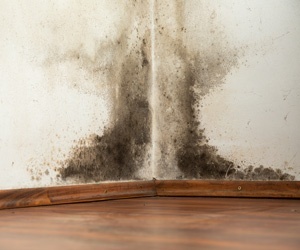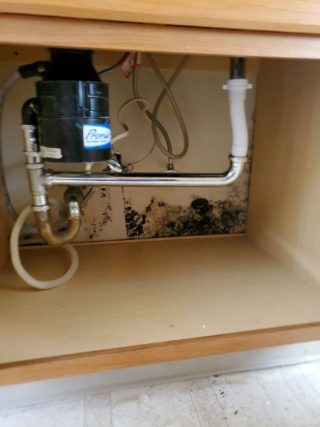Guide to Safety and Black Mold Removal
The words “black mold” can easily strike fear into the hearts of homeowners everywhere. No one wants to deal with the headache of a mold outbreak or the possible health concerns associated with it. But what exactly is black mold and is it as scary as it seems? Keep reading to learn more and explore the answers to some of the most frequently asked black mold questions.
What is Black Mold?
Black mold, or Stachybotrys chartarum, is a type of mold that can grow in homes and buildings. There are many different species of mold. Not all of them are toxic, but several types, including Stachybotrys chartarum have been proven to pose negative health effects on humans. Learn more about Stachybotrys chartarum on the CDC website.
Black mold is often dark in color and appears as blackish-green or brownish-black spots with a slimy texture, or gray and powdery if it dries out. It loves moisture and is frequently found in previously flooded homes and areas with leaky pipes or water damage, on moist surfaces such as fiberboard, drywall and gypsum board. Black mold is also commonly found on insulation, wallpaper, carpet, wood and ceiling tiles. People report that black mold smells like dirty wet socks, rotten wood or paper, and stale and musty.


Is Black Mold Dangerous?
Not all black mold is toxic and not all toxic mold is black. Molds produce allergens, and as with all allergens, people have varying levels of reactions to them. Black mold can be dangerous for people with asthma, respiratory allergies or weakened immune systems, especially seniors, pregnant woman, and infants. Inhaling or touching mold spores can cause negative health effects such as flu-like symptoms, trouble breathing and intense fatigue. Prolonged exposure to black mold can lead to lung damage, infections, and other respiratory issues in some people.
What Do I Do If I Find Black Mold in My Home?
Mold is an unwelcome, yet common visitor in homes and there are many common places where it can grow. If you find black mold in your home, do not panic. If it is in a small, contained area less than ten square feet, you may be able to safely remove it yourself. Do not touch it with your bare hands and resist the urge to remove it immediately because that could cause the mold spores to spread into your vents and create a larger problem. Ventilate the area by opening windows or doors.
What Is the Best Way to Test for Black Mold?
When you suspect you have black mold, there are a variety of home mold test kits you can purchase to test the mold for yourself. These tests can be quick, convenient, and relatively inexpensive. Some test kits tell you within minutes if mold is present and what kind. Other kits tell you if mold is in the air but do not identify the type.
Unfortunately, home mold tests are not as accurate as a professional mold test and are often used incorrectly. A professional mold test is quick and simple and often covered by your homeowner’s insurance.
Should I Call a Professional to Get Rid of Black Mold?
Yes, if you find mold in your home, it is always safest to have a professional mold remediation specialist inspect and evaluate the problem. Even if you do not seem to suffer ill effects from the mold in your home, it is important to determine where you have mold, what type it is and how to remove it completely and safely.
What Items and Materials Can Combat Black Mold?
A variety of common household products can help combat black mold in your home including:
- Bleach
- Baking soda
- Borax
- Vinegar
- Hydrogen peroxide
- Chemical based mold and mildew removers (such as these options available at Home Depot)
You will also need:
- HEPA vacuum with wet/dry capabilities
- Spray bottle
- Brush and rags
- Large trash bags
What Safety Gear Should I Wear to Remove Black Mold?
If you choose to tackle the job of removing black mold from your home yourself, it is important to be as safe as possible while doing so. Proper clothing and equipment (as suggested in the EPA’s Brief Guide to Mold, Moisture and Your Home) will protect you from black mold exposure. You will need:
- A respirator rated to protect against spores that can lead to black mold poisoning.
- Clothing that covers your skin, such as a long-sleeved shirt and long pants or a special suit.
- Safety goggles without ventilation holes to protect your eyes.
- Rubber gloves to protect your hands. Remember to discard your gloves and get a new pair when you take a break or finish your work.
How Do I Get Rid of Black Mold?
There are two options to removing black mold from your home. You can choose to tackle the job yourself or you can hire a professional to remove it for you.
Option 1: DIY Black Mold Removal
The DIY method is only recommended for small jobs of less than ten square feet. According to the Occupational Safety and Health Administration (OSHA), the proper method for mold removal is to:
- Put on all personal protective equipment (PPE) before starting — respirator, gloves, goggles, protective clothing
- Make sure your working area is well ventilated
- Place mold damaged materials in a plastic bag and discard
- Clean mold off hard surfaces and other nonporous materials with detergent and water, and dry completely
- Disinfect these cleaned surfaces with one of the following household bleach solutions:
- ¼ cup household bleach per 1 gallon of clean water for light contamination.
- 1 ½ cups household bleach per 1 gallon of clean water for heavy contamination.
CAUTION: Do not mix bleach with other cleaning products that contain ammonia. Highly toxic chlorine gas can be produced.
Option 2: Professional Mold Removal and Remediation
The safest way to remove black mold completely from your home is to hire a professional mold removal and remediation company. Letting the experts take care of the problem will give you peace of mind and assurance that your home is black mold free. Professionals have the equipment and training to safely eliminate any type of mold.
At East Coast Mold Removal and Remediation, the steps to our mold remediation process include:
- Evaluation — A remediation specialist will visit your home to visually determine if you have mold and identify both the type and cause of the mold. They will take samples from the air, the surface and the surrounding dust to identify the mold and its concentration in your home.
- Inspection — An Indoor Environmental Professional (IEP) will also examine a variety of other spots for mold, such as under grout, in HVAC vents, fireplaces, and on your mattress.
- Remediation — Once the cause of the mold has been remedied, all affected material is removed in thick, double plastic bags while the affected areas are treated with commercial black mold remover. A state-of-the-art vacuum system and safety-first products are used to ensure all mold is removed. Then high-tech fans and dehumidifiers are used to eliminate any leftover moisture.
- Verification — The IEP will perform another visual evaluation and take any additional lab samples of the remediated areas if needed or requested. The IEP will confirm that the mold is gone and that we have left your space in like-new condition.
How Do I Prevent Black Mold from Returning and Keep My Family Safe?
Eliminating moisture in your home is the key to preventing mold growth. Even though it is impossible to completely rid a home of mold spores, since they are often found floating in the air and in house dust, indoor mold growth can be squelched by following these simple tips:
- Repair leaks as soon as possible
- Keep humidity levels below 50%
- Clean up spills
- Use exhaust fans when cooking or showering
- Don’t keep plants in levels of high moisture
- Use dehumidifiers during the warm months
Read more detailed tips to prevent mold.
Trust the Professionals
At East Coast Mold Remediation in Baltimore, MD, we are here to help our community keep their homes mold-free and their families healthy. We provide top-notch black mold remediation services and make it our priority to put our customers first.
When you trust the team at East Coast Mold Remediation, you will have peace of mind knowing we are an Institute of Inspection, Cleaning, and Restoration Certified company (IICRC) that follows the IICRC Standard and Reference Guide for Professional Mold Remediation to the letter. To learn more about how we can safely remedy your black mold problem, contact us today to speak with a member of our mold remediation team.


